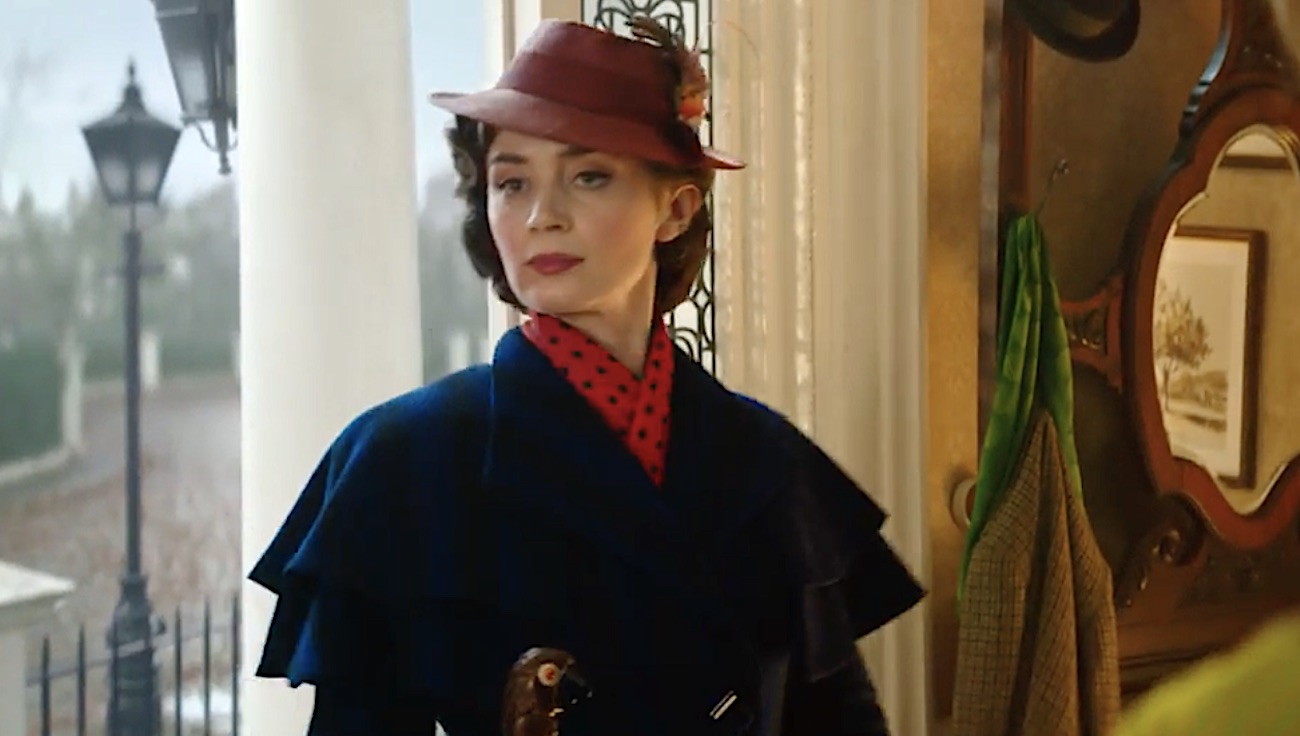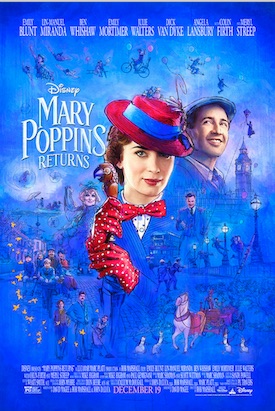 Now an adult with three children, bank teller Michael Banks learns that his house will be repossessed in five days unless he can pay back a loan. His only hope is to find a missing certificate that shows proof of valuable shares that his father left him years earlier. Just as all seems lost, Michael and his sister receive the surprise of a lifetime when Mary Poppins — the beloved nanny from their childhood — arrives to save the day and take the Banks family on a magical, fun-filled adventure.
Now an adult with three children, bank teller Michael Banks learns that his house will be repossessed in five days unless he can pay back a loan. His only hope is to find a missing certificate that shows proof of valuable shares that his father left him years earlier. Just as all seems lost, Michael and his sister receive the surprise of a lifetime when Mary Poppins — the beloved nanny from their childhood — arrives to save the day and take the Banks family on a magical, fun-filled adventure.
Disney’s original Mary Poppins was one of the most important films of my childhood. When I first learned that they were making a sequel, I was terrified that it wouldn’t live up to the previous film, so I was delighted to discover that Rob Marshall’s Mary Poppins Returns retains much of the charming, magical nature of the original. Emily Blunt is more than “practically perfect” as the nanny who returns to Cherry Tree Lane once again to help a desperate family. The rest of the cast, including Lin-Manuel Miranda, Ben Wishaw, Emily Mortimer, Julie Walters, Colin Firth, and Meryl Streep add immeasurably to the fun. I so enjoyed sitting down with Oscar-nominated screenwriter David Magee (Finding Neverland, Life of Pi) talk about the process of revisiting these characters.
Danny Miller: The original Mary Poppins was truly a seminal part of my childhood. So much so that I went into this film a little skeptical, thinking they better not fuck this up! So I was delighted at how moved I was by this story.
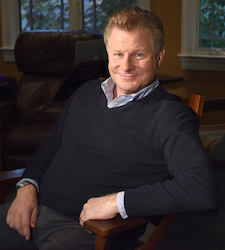 David Magee: (Laughs) I know a lot of people felt that way! People like you, who saw it in the theater when they were kids, and also young people who have watched it through the years on video.
David Magee: (Laughs) I know a lot of people felt that way! People like you, who saw it in the theater when they were kids, and also young people who have watched it through the years on video.
I know it’s widely available now but I do think it’s different for those of us who saw it when it first came out. I remember dressing up to go to the big movie palace in downtown Chicago and just letting the film wash over me. It made such a huge imprint!
I felt the same way. Those early movies — there wasn’t as much distinction between what was real and what wasn’t and it all became part of the bigger conversation about what life was about.
Totally. What kid didn’t want Julie Andrews to be their nanny? And the very first movie I ever saw in a theater was The Three Lives of Thomasina the year before, also starring Karen Dotrice and Matthew Garber, so I practically saw them as my brother and sister at that point. What a thrilling opportunity it must have been to bring these characters back to life. Were you at all terrified about tackling something this iconic?
You know, it’s funny, I really wasn’t scared, I was just excited at the chance to work with Rob Marshall. I had worked with Ang Lee on Life of Pi which everyone said was a really difficult film to adapt so I was up for the challenge. And from the moment I began working with Rob, I felt like we were having the same conversation.
By the way, I loved Finding Neverland and if I was thinking about making a sequel to Mary Poppins, I would have said, “Get me that Finding Neverland guy!” When you started writing, how blank was your slate in terms of what the story should be? I assume you already knew that the film would be set a certain time in the future?
No, we didn’t actually start with that question. We began by talking about the feelings from the first film that we wanted to capture. And the very first question we had to wrestle with was why does Mary Poppins come back? I mean, if she did such a wonderful job saving these people’s lives and teaching the parents the value of family and all of that, why does she return? We struggled with that for a while. We had all sorts of different scenarios in which she came back to the original family. We read all of the P.L. Travers books and talked about how the first book was written during the Depression, or the “slump” as it was called in London. One of the first descriptions in the book of the Banks’ home on Cherry Tree Lane was that it was one of the shabbiest houses on the street. Disney moved the story back to the Edwardian era because they wanted to show a lighter time period so we thought it would make sense to set our film in the 1930s since these were written as contemporary stories.
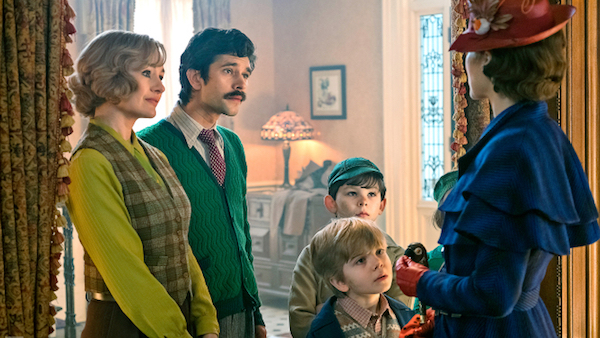
Ah, I just assumed that you were always going to have it revolve around a grown-up Michael and Jane.
That was our big revelation that came later, after we’d been working on it for a while.
Definitely the right decision, in my opinion. It’s one thing to have the wonderful Emily Blunt as Mary Poppins, but I don’t think I could have handled new actors replacing all of the Banks family members!
Yeah, that was part of it, too. We wanted a new story, not just to see what happened the next day after the first film ended. The real turning point came when we decided on setting the film during the Depression with Jane and Michael as adults. There’s a wonderful line in one of the books, “Grownups forget, they always do.” As soon as we connected that idea to Jane and Michael, we knew we had a story.
And it was such an important time in England when so much was changing. My wife and I always joke before we see a Disney movie, “Okay, which parent dies?” Was there ever a version in your head in which Michael’s wife was still alive?
We did have versions in which Michael’s wife was alive and also one showing them losing her, but then we decided we didn’t want to do that. We didn’t think this should be a film about the wife dying at the end of the first act, we wanted to start later than that, when the joy had gone of Michael’s life, when he’d gotten lost along the way, and when he was reaching that crisis point where he didn’t know what to do next or where to turn.
The perfect time for Mary Poppins to return!
Exactly! And the threat of losing the house became a kind of metaphor for all of the loss the family had experienced.
Right, not only memories of Michael’s late wife, but also of his parents and Jane and Michael’s magical childhood with Mary Poppins.
That’s it. And while Mary Poppins comes back to help the young Banks children, she’s also coming back for Michael who has lost what he had as a child.
Just like her real mission in the first film was helping George Banks.
Absolutely.
And again, as much as I worship Julie Andrews, Emily Blunt did such a fabulous job as Mary. Was she in your head as you were writing the script?
She was in Rob’s head from the beginning, for sure. But she wasn’t cast yet. We weren’t about to approach her or anyone else until we knew we had a story we wanted to tell. It took three or four months of sitting in a room with Rob, John DeLuca, Marc Shaiman, and a few other people to come up with a story that we could show Disney.
Were there ever any moments where Disney objected to what you wanted to do with these beloved characters?
Actually, no, they were remarkably hands-off, but, of course, they have an immense amount of trust in Rob and John who’ve done several films there. So, we ended up working on it for months and polishing it up and we came up with a 35-page treatment of the film.
One that included specific holes where the songs would be inserted?
Yes, for sure. And then as I wrote the screenplay, we’d work in a very collaborative way throwing out ideas for what each character had to express and if they could do that through a song. I’d go off and write the scene up to the point where I thought the song began and a little past that to show what emotions lead up to it.
As a fanatic of the original film, I found myself combing through every image on the screen and every word of dialogue to find links to that world of my childhood. I love how those links were there, but sometimes very subtly. For example, going in I was desperate to see Mrs. Banks’ “Votes for Women” suffragette banner and I just loved how it showed up in the new film in such a prominent way without ever mentioning it directly. It made me wonder how much of your source material was the original Disney film as opposed to the P.L. Travers books.
Both, actually. From the beginning, we were determined that this had to work as a standalone film, but we also knew that many of our viewers will have seen and loved the original and we wanted to respect and do justice to that as well without constantly winking and pointing and going, “Remember how great that movie was?”
You really nailed it — it’s almost more satisfying to see all those connections without beating us over the head with them. Like seeing the Michael and Jane’s snow globe without any water in it.
Exactly. We wanted to be part of that world, but also acknowledge that the world of the original film had changed in many ways. We talked a lot about the kite from the first movie. Michael finds the kite in the attic and throws it out. I had the idea of having it blow away on its own and then serving a different purpose in the film. Someone along the way said it nicely: “It’s not the same film, but it rhymes!” We wanted to feel that we earned all of our comparisons to that world.
I hate when people label such films as schmaltzy but was that something you worried about? I thought you did a great job of balancing the pathos in the film like when Michael sits down and cries late in the film. Again, that was earned. And, of course, Mary Poppins is the opposite of sweetness and light.
That’s it, I think you’re answering the question! To me, Mary Poppins is not sentimental, she’s not gushy, she’s not lachrymose. We didn’t want to beg our audience to feel sorry for our characters. So when Michael, played by Ben Whishaw, says to the lawyers in the opening scene that his wife passed away recently and one of the lawyers says, “I’m so sorry,” he just moves on and says, “Thank you, so what’s going on?” It’s only when he’s in the privacy of the attic, frankly, that he remembers for a moment how much he’s going through. And that’s just real. I know many people who have lost spouses and loved ones who don’t wear their hearts on their sleeve.
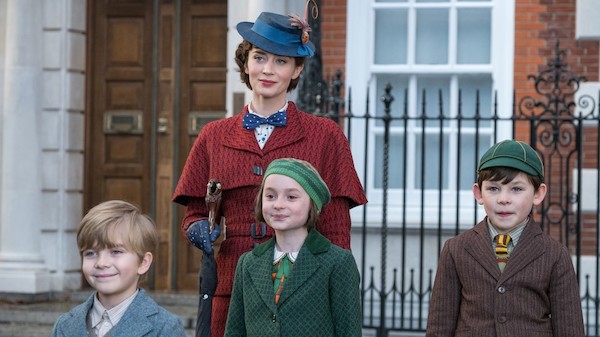
I guess the biggest risk of schmaltz comes when you have very young actors bursting into song. But those kids were so talented and never overdid it on the sweetness.
Yes, they did an amazing job. And again, remember that the children don’t mention their mother until almost halfway into the film when the youngest says, “I miss Mother.” That’s all they ever say about her.
As great as all of the actors were — Emily Blunt, Lin-Manuel Miranda, Ben Wishaw, Meryl Streep, and so on — my favorite might be Emily Mortimer as Jane Banks. I thought she was absolutely perfect in that part. Did you create backstories for all the characters so you could know what happened in their lives between the first one and this? It made total sense that she was the daughter of a suffragette!
Yes, we absolutely talked about what the impact would be of having those parents. We decided that Jane would pick up her mother’s love of good causes so that became our starting point for her. And with Michael, we decided he wasn’t a banker by nature, but we liked the idea that at a certain point he would have to become one, which was an interesting kind of reversal so that he was an artist at heart who had to become a banker.
Well, thank you so much for bringing all these people back into life and, as I’ve said, for not fucking it up!
Haha, let’s put that on the poster. Thank you, this was fun!

